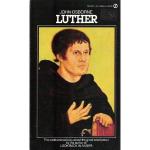|
This section contains 290 words (approx. 1 page at 400 words per page) |

|
Luther Summary & Study Guide Description
Luther Summary & Study Guide includes comprehensive information and analysis to help you understand the book. This study guide contains the following sections:
This detailed literature summary also contains Bibliography on Luther by John Osborne.
John Osborne's Luther, which debuted in London in 1961, is a drama with a historical setting and a timeless theme. As Osborne told an interviewer in 1961 (as quoted in Alan Carter's John Osborne), "I wanted to write a play about religious experience and various other things, and this happened to be the vehicle for it. . . . I hope that it won't make a difference if you don't know anything about Luther himself, and I suspect that most people don't." He added his belief that "the historical character is almost incidental." The play focuses on Martin Luther, the sixteenth-century monk who publicly spoke out against age-old practices and beliefs of the Roman Catholic Church, thus beginning the Protestant Reformation. Osborne, however, focuses on Martin Luther's intensely personal reaction to his religion, his faith, and his God; the transformations he wrought in Europe exist more as an aside in this drama.
As he did in earlier works, such as his groundbreaking Look Back in Anger, Osborne profiles an individual in conflict with authority, which in Martin Luther's case is the vast authority of the Roman Catholic Church. In posting his 95 theses, Luther risked inevitable excommunication and brought the wrath of the highest church leaders, including Pope Leo X, upon him. He did this despite his uncertainty about what would come next, for, as he tells Cajetan at the Diet of Worms (a city in Germany) about the Roman Catholic Church, "A withered arm is best amputated, an infected place is best scoured out, and so you pray for healthy tissue and something sturdy and clean that was crumbling and full of filth." Osborne dramatically depicts how Martin Luther followed his convictions in the face of great doubts, and so transformed Christianity forever.
Read more from the Study Guide
|
This section contains 290 words (approx. 1 page at 400 words per page) |

|



